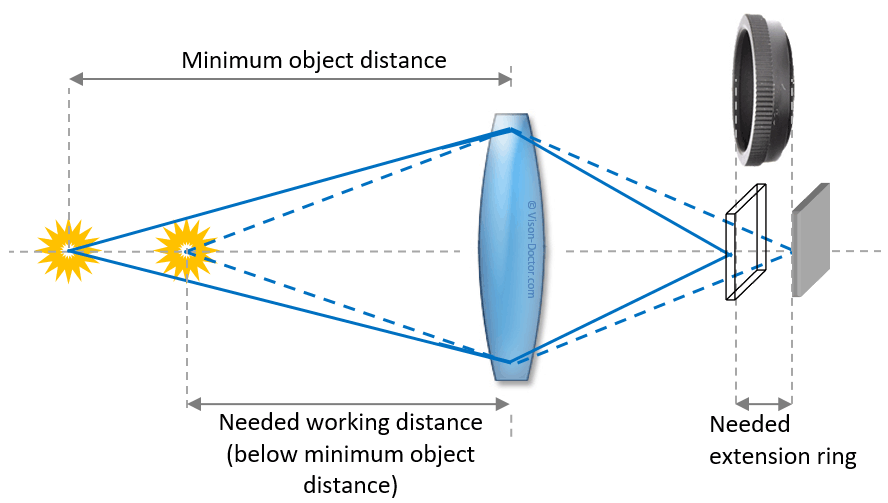Minimum object distance and close-up rings
Another term frequently indicated by optics manufacturers is the minimum object distance (MOD). It refers to the shortest working distance between the foremost lens and the motive which can still be focused using the focus ring on the lens. Rays of light from the object inciding in parallel all coincide in the focal point of the optics on the sensor side. If the test object comes closer to the optics, you have to re-focus, since the shorter distance makes the generated image move further and further away from the lens. When focusing the close range, the lens group is therefore moved away from the sensor.
The MOD strongly depends on the lens design and the mechanics of the optics and is clearly manufacturer-specific. Classic standard lenses from one manufacturer, for instance, can have a close-up limit of 200 mm, whereas lenses from a different manufacturer have an MOD of 350 mm.
In principle, the minimum object distance depends on the focal length and thus strongly on the depth of field of the lens. Especially wide-angle lenses therefore have a lower MOD. As the depth of field can be increased by stopping down the optics, the MOD can also be reduced a little bit in this way. However, this works out better when using close-up rings.
Close-up rings to undercut the MOD
The insertion of close-up rings between connection thread and camera enlarges the image distance, i.e. the distance between sensor and lens group. This trick serves to circumvent the close-up limit of the lens: by further reducing the working distance, the object field size can be reduced farther. Viewing small image details (e.g. 9 mm x 6 mm) with simple standard lenses is possible in this way and can be an inexpensive alternative to macro-optics. Close-up rings are universally applicable for diverse lenses and are part of the standard equipment of an image processor.
 |
- The smaller the working distance, the more close-up rings must be added. A wizard for the calculation of close-up rings can be found in the "Service" area.
- The larger the close-up limit for the optics used, the more close-up rings are required in order to view the same image detail.
- The more close-up rings are added, the more the luminous power of the optics decreases. A calculation of the effective focal ratio can be found in the "Service" area.
Significance of the minimum object distance (MOD)
By a clever arrangement and combination, optics manufacturers succeed in producing affordable lenses with reasonable effort, which have as few imaging errors as possible. Depending on the focal length, different refractive converging and diverging lenses are used in various combinations. The location of the system aperture, too, and further mechanic mounting edges have an influence on the limitation of the optical path at the image margin and therefore have a great influence on the image quality and distortion. Besides, lens groups can move towards each other or to the sensor position in different ways when focusing in order to ensure an ideal image quality.
Normally lenses are designed in such a way that they maintain their imaging quality up to an imaging scale of approximately 1:20. If the close-up limit is undercut artificially, the object may be depicted larger but imaging errors like distortion, astigmatism and coma strongly increase.
Whether the normal lens can also be used as inexpensive macro-optics by means of close-up rings and whether it meets the requirements for error detection and measuring accuracy, must be decided by the user.







